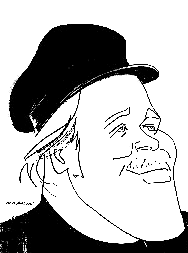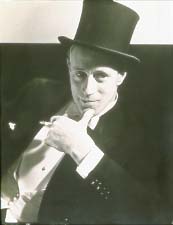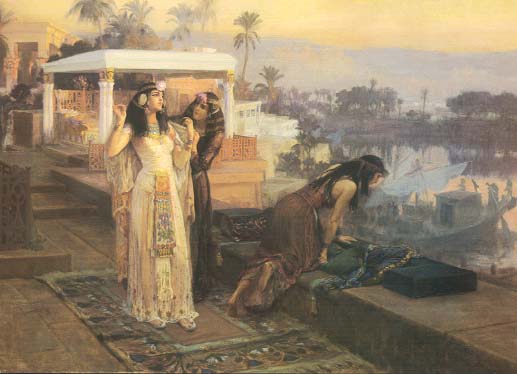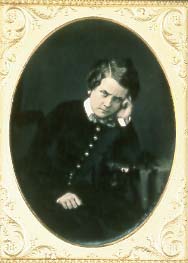Museums and Exhibitions in New York City and Vicinity
| Home | | Museum Guide | | International | | Architecture & Design | | Theater |
GLENN LONEY'S MUSEUM NOTES
CONTENTS, October 16, 2000
[01] Treasures from Ancient Ukraine at the Brooklyn Museum

Caricature of Glenn Loney
by Sam Norkin.
[02] Scythian & Sarmatian Treasures at the Met
[03] Russian Amazons of the Avant-Garde at the Guggenheim
[04] The Gere Collection of Landscape Oil Sketches at the Frick
[05] Edward Steichen at the Whitney
[06] Barbara Kruger at the Whitney
[07] Orientalist works at the Dahesh
[08] Hip Hop Nation at the Brooklyn Museum
[09] Chinese Calligraphy at the Met
[10] Egyptian Art from Eton College
[11] The Year One at the Met
[12] Art & the Empire City
[13] Queen Victoria & Thomas Sully
[14] "La Divine Comtesse"
[15] New Arthur Ross Terrace at Natural History Museum
You can use your browser's "find" function to skip to articles on any of these topics instead of scrolling down. Click the "FIND" button or drop down the "EDIT" menu and choose "FIND."
For editorial and commercial uses of the Glenn Loney INFOTOGRAPHY/ArtsArchive of international photo-images, contact THE EVERETT COLLECTION, 104 West 27th Street, NYC 10010. Phone: 212-255-8610/FAX: 212-255-8612.
Copyright © 2000 Glenn Loney.
For a selection of Glenn Loney's previous columns, click here.
Outstanding Fall Exhibitions:
Note: Your Curators' Choice correspondent is filing this brief report between planes. He's just spent 19 days on a tour of China and Tibet—with report and pictures to follow in early November. Now he's on his way again, this time to Ireland and the Wexford Opera Festival, the Rock of Cashel, and the Ring of Kerry. More later! GML

| |
| SCYTHIAN HUNT--Symbolic Scythian Golden Stag in hunting scene from 4th Century BC, on loan from Ukraine & on view at Brooklyn Museum. See: "Outstanding Fall Exhibitions." | |
All of the 170 finely wrought treasures on view in Brooklyn are from three major institutions in the Ukraine. Even though many of these magnificent artifacts are some 2,500 years old—or more—some of the most impressive have only been excavated in the past decade, after the Ukraine became free of the former Soviet Union.
Highly stylized ritual animal images distinguish many of the artworks. Evidences of Greek inspiration and workmanship are apparent, but there are distinctive Scythian details as well.
One of the finest artifacts is a golden helmet, depicting Scythian battle-scenes in relief.
All of the objects have been recovered from Scythian Kurhans, or burial mounds, some of them as large as small hills. In these ceremonial tombs, great chiefs were buried in rich adornments, prepared for life in the next world. Wives, servants, and animals were sacrificed to accompany them. Horsemen were impaled on their horses in a ring surrounding the tombs.
There are still some 40,000 unexcavated burial mounds in the Ukraine, promising even more astonishing treasures.

| |
| GOLDEN ANTLERS-- Symbolic Scythian Golden Stag from ancient burial mound, on loan from Hermitage & now on view at Met Museum. | |
This dazzling show would not have been possible, however, had it not been for the foresight of Peter the Great in the 18th century. When precious objects of ancient gold appeared on the market, this visionary Russian ruler decided that such treasures should be preserved by the state. And that further excavations of burial sites be conducted under imperial auspices.
As a result, even 250 years ago fledgling Russian archeologists were complaining about the depredations of grave-robbers who had got into the tombs before they did.
Apparently, then as now, the difference between grave-robbery and scientific excavation & investigation is a matter of both the systems used to recover the art-objects and their ultimate destination: private collectors or art museums.
There is a plethora of Golden Stags with immense golden antlers in the current show. These impressive cult objects have amazingly survived over two millennia in the earth of the steppes.
The image of the antlered stag is found in a number of artworks, notably in golden plates which used as jewelry, applied to arrow-cases, and sewn onto clothing.
The most remarkable object in this large exhibition is in fact very small. It is a golden comb with amazingly detailed modeling of the faces of some ancient combatants on its crest.
Brooklyn Museum staffers who checked out the Met's show noted that the maps used to indicate sites where Scythian Gold has been recovered did not even once refer to the Ukraine!
The current Guggenheim exhibition celebrates the achievements and fantasies of Alexandra Exter, Natalia Goncharova, Liubov Popova, Olga Rozanova, Varvara Stepanova, and Nadezhda Udaltsova.
There are more than 70 of their paintings and sketches on view.
At the Guggenheim Museum—
[Russian] Amazons of the Avant-Garde
[Closing January 7, 2001]
Before Stalin's demands for Socialist Realism in Soviet Art crushed the free spirits and wild imaginations of Russian artists, a group of innovative women artists were in the forefront of stylistic experiment—even before the 1917 Revolution. At the Frick Collection—
A Brush with Nature:
The Gere Collection of Landscape Oil Sketches

| |
| CASCADE AT TIVOLI--One of the outstanding oil sketches now on view at the Frick Collection. | |
But the special freedom which such rapid sketching often occasioned gives such studies a vitality and impact not always to be found in the artists' formal academic renderings.
Art historians John & Charlotte Gere began collecting such studies in the 1950s. At the Frick, some sixty oil sketches from their collection are on view. Notably some by Corot and Degas.
At the Whitney Museum of American Art—
EDWARD STEICHEN
[Closing February 4, 2001]

| |
| LESLIE HOWARD--Edward Steichen's vintage portrait of the elegant English film-star, now on view at the Whitney Museum. | |
Almost 200 vintage photos are on view. This is the first full retrospective of his work since 1961.
Many of the images are little larger than a sheet of bond paper. As there are so many of them on display—set very closely to each other—there are crowds of people trying to get close enough to study each photo and digest its caption.
There are a number of Steichen's fashion photos on view, some of them now almost as famous photo-images as this innovative photographer's more stark documentary work.
His genius in compiling the Family of Man exhibition and book is also celebrated. Even though it was mounted at the Museum of Modern Art, not at the Whitney!
BARBARA KRUGER
[Closing October 22, 2000]

| |
| YOUR BODY IS A BATTLEGROUND--One of Barbara Kruger's provocative posters, shown at the Whitney Museum. | |
Kruger's signature colors are black, white, and red. Using vintage photos, accompanied by often astoundingly simple phrases, Kruger subverts popular conceptions and trends.
A former graphics and advertising designer, she has brought the methods of the media over into the art world. But she also employs the buzz-words and slogans of the media to critique current social and cultural values.
Even if Kruger's red-white-black room-sized installations are gone from the Whitney, you can still get the dramatic catalogue and Kruger T-Shirts! How about: YOUR BODY IS A BATTLEGROUND?
At the Dahesh Museum of Art—
A Distant Muse: Orientalist Works
[Closing December 30, 2000]

| |
| CLEOPATRA--An American "Orientalist" vision of Egypt's Queen Cleopatra VII on the terrace at Philae, now on view at the Dahesh Museum. | |
Although it's no longer PC to use the word Oriental, there was a time when it was definitely in vogue. But the term referred more precisely to the world of the Middle East in the declining decades of the Ottoman Empire. Rather than to China and Japan.
In conjunction with this small but powerful show, the Dahesh is also offering a series of lectures on the general theme: Influential Encounters: The Art & Politics of Orientalism.

| |
| ONE PICTURE WORTH A THOUSAND WORDS?--Chinese ideographs are images, as shown in this Huang Tingjian calligraphy at the Met Museum. | |
In fact, this very special show is all about the images evoked by strong calligraphies. Thoughtful texts explain symbols and meanings for the uninitiated.
Chosen from the works of Chinese masters, some 55 calligraphies are now on display. They cover a range of a thousand years, up to the present.
Egyptian Art at Eton College
[Closing January 21, 2001]

| |
| ORYX AS COSMETIC DISH--Ancient Egyptian beauty-aid from Eton College's Myers Museum current loans to Met Museum. | |
But by the severe selectivity of the objects chosen—and their intrinsic beauty of design and execution—this show focuses attention on details often lost in large-scale stretches of exhibition cases crammed with scarabs and the like.
There are some 150 objects on display, all worth a close examination and a thorough reading of the accompanying texts.
Its imaginative new exhibition celebrates the art that was being created, both East and West, at the time that Jesus was born. That means there is no Christian art on view, as no one—except possibly the Three Wise Men—had any idea of what was to come.
Instead, the gods, potentates, and even ordinary men and women of the Ancient World were being depicted by artists and sculptors.
150 must be a Magic Number at the Met, for this show also offers some 150 art-objects—largely from the Met's collections—made a millennium ago. They do serve to put the Year One in some kind of stylistic/thematic context.
Long before 1492 or Lief Ericson, native artists were at work in the Americas, so some New World artworks from the Year One are also on view.
THE YEAR ONE:
[Closing January 14, 2001]
If you are still confused about the actual date of the beginning of the New Millennium, the Met Museum seems to favor the Year One as a good place to start counting.
Art of the Ancient World East & WestArt & the Empire City:
[Closing January 7, 20001]
New York, 1825-1861

| |
| MATTHEW BRADY PRESENTS--Collectible portrait by famous American photographer, representing mid-19th century emergence of distinctive taste and culture in New York, the Empire City, now at the Met. | |
With a range of some 300 objects, artworks, graphics, and documents, this unusual survey of the development of New York's consciousness of itself as a center of culture provides some fascinating insights into what was admired and valued at that time.
Of course the emergence and achievements of American artists are celebrated. But there is also ample room in the show for the European and English art and artifacts which were so enthusiastically collected by prosperous New Yorkers.
Queen Victoria & Thomas Sully
[Closing December 31, 2000]

| |
| YOUNG VICTORIA--Thomas Sully's lovely sketch of the 18-year-old queen, now on view at the Met. | |
The Met Museum is marking Victoria's passing with this charming exhibition, featuring Thomas Sully's lovely portrait of the 18-year-old queen. It shows her in her coronation robes, as if she were ascending the throne, looking over her right shoulder at the viewer.
This image was widely copied for engravings in many lands. Samples of the various copies are also on view, as well as other examples of this Philadelphia artist's experiences and work in England.
"La Divine Comtesse"
[Closing December 31, 2000]
Photographs of the Countess de Castiglione

| |
| LOGO IMAGE FOR "THE DIVINE COUNTESS"--Fascinating photo-portraits of mysterious Countess de Castiglione, who was obsessed with her own image in costume, now at the Met. | |
I saw it there last November, but—even though it was more comprehensive than this Met mounting—the cramped, awkward spaces in which it was displayed dissipated its potential impact.
A great beauty and a mysterious mistress to Emperor Napoleon III—among others—the countess was sent to Paris by the great Italian liberator, Cavour, to secure the emperor's support for the cause of Italian unification.
Espionage and lobbying for the Rissorgimento didn't divert the countess from her mirror or her infatuation with her own image in photographs. She had herself photographed in various elaborate court and ball-gowns, as well as costumed as characters in fiction and drama.
Over a span of 40 years, court-photographer Pierre-Louis Pierson caught the beautiful countess' varied moods and disguises in some 400 photos. This was unique in its time, though moderns such as Cindy Sherman may well have exceeded the countess in the self-portrait sweepstakes.

| |
| NIGHT AT THE SPACE CENTER--New Arthur Ross Terrace after dark at the American Museum of Natural History. | |
Constructed over a large new parking-facility, the terrace has new trees, set below paving stones laid on a metal grid, so burgeoning roots will never disrupt the pavement. Between the public areas and the Space Center is an ingeniously designed plateau with a number of water jets to soothe the eye, ear, and sinuses.
Bring your lunch! [Loney]
Copyright © Glenn Loney 2000. No re-publication or broadcast use without proper credit of authorship. Suggested credit line: "Glenn Loney, Curator's Choice." Reproduction rights please contact: jslaff@nymuseums.com.